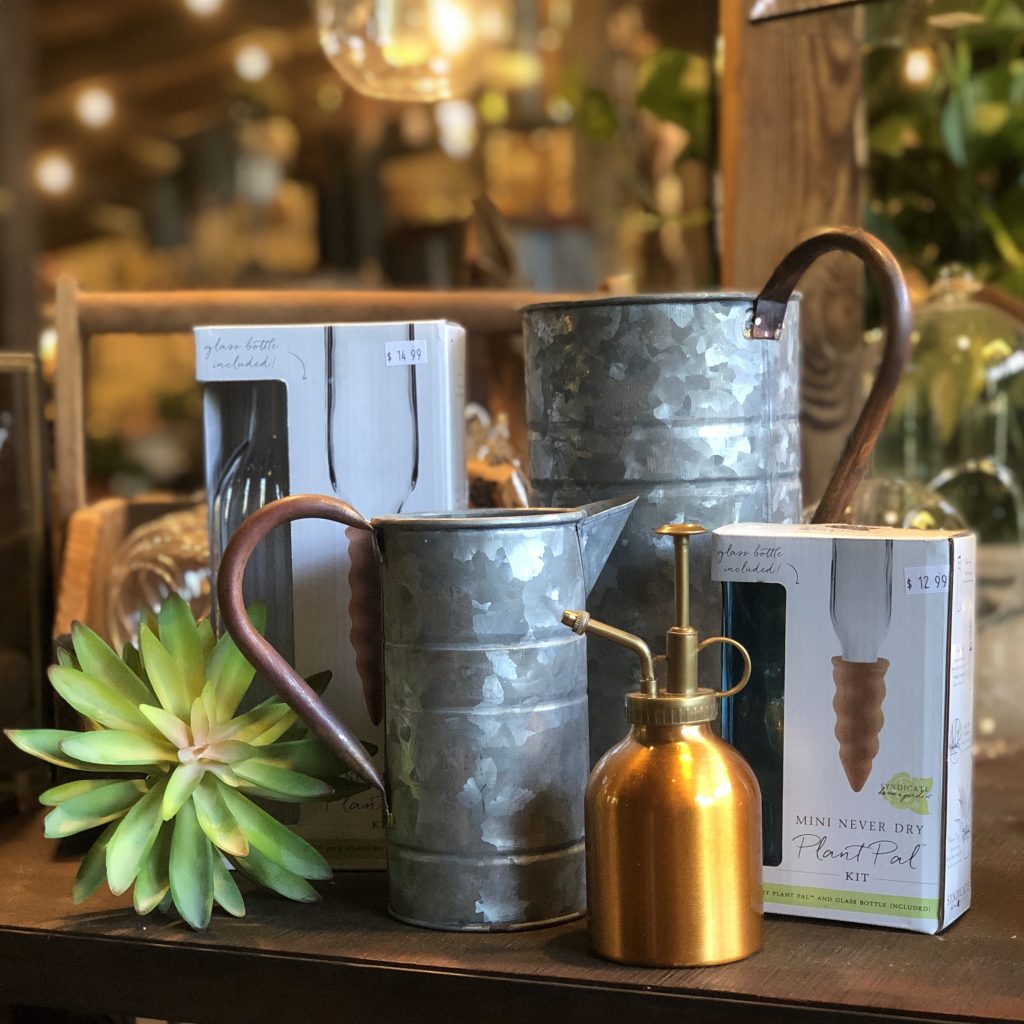Handy Watering Tools for Houseplants

Misting Houseplants
We talk a lot about watering…. why is it so important? Well, all plants need water. And when we take them out of their natural environment and place them in less ideal spaces, we need to create a healthy environment for them. Most of our homes are temperature controlled, which in Arkansas is almost a necessity! Tropical houseplants originate in areas with high humidity and grow best in that environment. This is why misting your tropicals is key, especially during the winter when the heat is running. The heating process takes moisture out of the air; frequent misting raises the humidity around them. And bonus, we have some really cute misters to choose from, so they double as decor!
To further help your houseplants, keep them away from air vents if possible, especially during the winter.
Watering Houseplants
Most plants require watering of the root system too. Air plants are an exception; they do well with frequent misting only but a good dousing doesn’t hurt! We often have customers bring in or send in images of their struggling plants. At least 50% of the time, the issue is a result of over or under watering. And we get it, it can be difficult to determine what is happening in the root system of a plant. And often times the symptoms are similar.
That’s why we suggest Moisture Meters; they are an inexpensive way to see what is happening down in the root area of the soil. They are also a wonderful way to learn more about the water needs of your houseplants, both how often and how much to water. We talk about them enough to have done a whole blog post just on them; check it out here.
Ask us questions when you pick out your plants; we can give you advice about the water needs of your plants. If your plants are struggling, bring them by or if they are too large, bring us picture of them. Usually, if the issue is quickly addressed, they can be saved.
Have a watering can handy and in sight. Sometimes it takes a visual cue to remember to water. There is a better chance of you remembering to water if your watering can is located where you see it or will come across it regularly. Remember to empty the watering can if it is outside to keep the mosquito population from growing. If it is kept inside, you can leave it with water in it, tuck it into a place where it won’t get knocked over though. In general, tap water is just fine to use, but if it has a strong chlorine smell, avoid using it on chlorine sensitive plants, such as dracaenas, cordylines, spider plants, prayer plants and carnivorous plants. For these plants, using distilled water is recommended.
Forget to Water?
Another handy watering tool for houseplants is the Plant Pal. Whether you have a tendency to forget to water your houseplants or you are going to be away for many days, Plant Pals can help. They are very easy to use and the kits include everything. Just insert the ceramic applicator in the plant soil, fill the bottle with water, and put it in the ceramic applicator. Yup, that easy! Take note of how quickly the water empties and put refilling the bottle in your calendar to remind yourself to check it.
Plant Pals work for larger plants but they would be difficult to use in pots four inches or smaller. For these, make a habit of checking for watering on the same days of the week. For most, that could be just twice a week and they may not even need water every time (this is where that Moisture Meter is handy!). Try not to place plants in areas that you don’t pass by often. If that hidden space really needs a plant, (we know, decor matters!) choose plants with low water requirements that can withstand drought conditions. ZZ Plants are wonderful options for this kind of space!
Proper Drainage is Key
Consider the drainage in your container, as in, does it have a drainage hole in the bottom or not? This impacts how the plant should be watered; if there isn’t a way for excess water to gather away from plant roots, add gravel to the bottom of the container and water less often, or plant in a separate container that can be removed for watering.
Leaching the Soil
Leach the soil once a month. This is the process of watering thoroughly, and letting excess water drain out. Watering is usually accomplished by giving the plant a smaller portion of water. This can cause salts to build up in the soil, especially when using full rates of fertilizer. Leaching both effectively rinses some of that salt out of the soil and introduces fresh air into the soil. Plant roots thrive on fresh oxygen. Water all the way around the plant; only watering one side of the soil mass could result in a decline of the roots on the continually dry side. Frequency and amount of water both matter; water an appropriate amount at the appropriate frequency.
Thanks for taking the time to learn more about these handy watering tools for houseplants! Want to keep learning? Check this post out Top 10 Houseplant Tips and Tricks